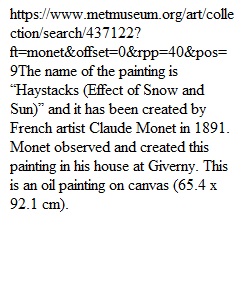


Q Read chapter four well. This will help prepare you for your Virtual Art Museum Field Trips! Visit the websites for several of the museums listed in the Website Adventure in this session. (Visit "at least" three art museums.) Remember to look for the links to "collections," "permanent collections," or "exhibitions" (although links for exhibitions may be limited). Following your virtual field trips, choose a painting that appeals to you and read any information that may be available concerning the painting and/or its creator. Because this week’s chapter is about painting, please restrict your selections to paintings only—no drawings, sculptures, photographs, etc. Include a photo of the painting you are discussing (or at least a web address linked to your painting.) To complete this journal assignment, number (1 – 5) and answer each of the following discussion questions: 1. Provide a way for me to see your choice— download the picture of your painting, or either supply the URL, or give directions to navigate to the place where the picture can be viewed. It is very important that I should be able to see the painting you have selected. 2. Give the facts about the painting you have chosen— provide the title, the name of the artist, country of origin, when it was created, and the medium (oil on canvas, tempera on wood panel, mixed media on glass, etc.). 3. Tell why you chose this painting, how it makes you feel when you look at it, and what you think the artist was trying to say when he/she painted it. 4. Describe the painting, and provide the following information about the work of art: A. What colors are predominant— is it warm or cool? B. What kinds of lines predominate— vertical, horizontal, diagonal, or curving? C. What do the lines tell you about the subject? D. Is the painting representational or abstract? If objects are presented, are they presented realistically? Do the objects occupy space realistically or not? 5. Discuss anything else that you noticed or that grabbed your attention about the work. In this part of your analysis, try to focus on what you literally see without regard for your personal opinions or feelings. Remember, your participation and response should reflect your reading and understanding of the chapter and content for this session. Include a photo of the painting you are discussing (or at least a web address linked to your painting.)
View Related Questions